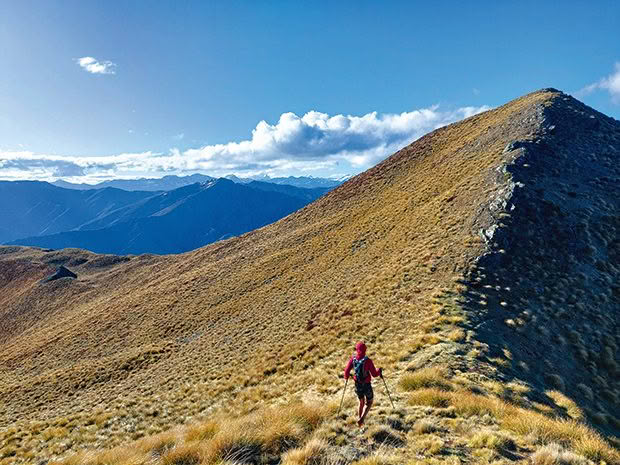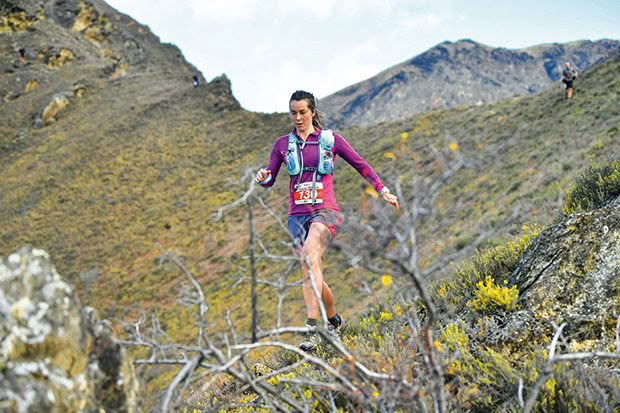The trials and triumphs of the ultra-marathon

Queenstown’s attractions led a new arrival towards the region to ultra running. It has become a voyage of self-discovery.
Words: Heather Kidd
Just as the words horse and carriage and love and marriage go together, so too do insanity and ultra running. Who in their right mind chooses to run distances of more than a marathon? Five-, 24-, 30-hours-plus across often tricky terrain, running from daylight to sundown and sometimes through the night. Surely it falls outside the norm to want to push beyond what your limits might be and to embrace pain, physical and mental, willingly? Why would a person do that?
Bindy Griffin’s initial “why” was a mix of curiosity and opportunity. When she and her husband, former New Zealand Olympic skier Ben Griffin, moved to Queenstown seven years ago, she discovered the trail network that crisscrossed the scenic region.
“Starting out, I was curious. I hadn’t known trail running was a thing. I grew up in Christchurch and studied law at university there, and all the time played sports like netball and basketball.
“When Ben and I moved to Queenstown, I remember looking at a hill and wondering if I could run to the top without stopping. It took me a couple of goes, and I was like, ‘Okay, I wonder if I can run to the top of another one.’”
She could. And not only that, she found it fun. By the end of that first summer, she entered Cromwell’s Mt Difficulty half-marathon over steep and rocky terrain. “It’s a tough course, but I enjoyed it, and my curiosity grew from there.”
Bindy (34) ran her first official ultra in 2018. The Motatapu run takes participants from Glendhu Bay in Wānaka to Wilcox Green in Arrowtown. It’s 52 kilometres with a vertical elevation of nearly 2500 metres. The event tested her mettle, from pre-race nerves to stomach problems and getting enough nutrition during the run. But she did it.
For Bindy, making it to the finish line is always a top priority. “Many people are in it to win, but I’m not. I want to get a good time for me, and if I come up to someone on the trail, then yes, I want to beat them, but I’m not trying to be among the top finishers.”

How competitors fare often depends on the type of trail, with typography varying significantly. Bindy prefers hills — the more, the better. “Often, when it gets steep, you’re not really running, you are power hiking. I run the flatter bits and the downs, and that’s what I enjoy. I’m better on the downhills, and I know that’s where I can make up time or pass people. It’s about making the most of what you’re better at without going too hard. Go too hard on the downhill, and you risk blowing out your quads.”
Learning what her body can and can’t endure is one thing, another is that the actual “why” only starts to kick in when she’s been running for more than three hours. “The beauty comes once the suffering starts. You find out who you are when your back is against the wall. You also discover that feeling weak can be quite powerful, that you can be in a lot of pain but keep going. It makes you realise your strength, which is not something you learn in everyday life.”
Everyday life for Bindy revolves around a demanding job. She is a senior director in the marketing department of a legal workspace company. She works remotely, and much of her day is spent indoors and online.
Ultra running has become the perfect antidote to her fast-paced career. “I enjoy being outside in nature, connecting with all the weather, environments and terrains. There’s a kind of peace in it.”
Time spent alone is a key driver for Bindy; she enjoys running solo. “When I’m with people, I miss my connection to my surroundings and those quiet moments. There’s an introspection you don’t get when you’re running and chatting with others.”
In December 2022, she put her love of solitary running to the test, taking on The Wild. It was supposed to be a multi-day event in the hills around Arrowtown, but it was cancelled when the organising company went into administration. Bindy didn’t want her months of training to go to waste, so she opted to do the 160-kilometre ultramarathon alone. Ben, who joined her for the overnight section, was the only person she would see in more than a day.
It was a perfectly packaged experience of stunning scenery and horrendous conditions. “There wasn’t one part of it that was great. In fact, when I think about it, the fun parts were minimal,” says Bindy. “But as a collective, there was so much beauty. Being off trail and running in cool new areas.”
Having previously completed a 100-kilometre event, Bindy’s expectation of running 160 kilometres was realistic. However, the rocky and bush-clad terrain proved slow going, and 7500 metres of vertical climb also took its toll. Fog, frozen tussock and a cold southerly wind made the conditions exceptionally inclement; it was so cold the water in her drink bottle froze. After 30 hours on her feet and chilled to the bone, she reluctantly called it quits.
While she might not have achieved her goal, neither had she failed. She’d done the best she could in conditions that were treacherous and had experienced the beauty and the beast. She’d pushed herself to the edge of insanity but hadn’t stepped off the ledge.
And although the first official running of The Wild did take place in late 2023, Bindy wasn’t among the starting line-up. In December, she and Ben were busy with their own long-term project, preparing for the birth of their first child, a daughter.
TRAIN TO BE TOUGH
According to Bindy, training for an ultramarathon is almost more complicated than running a race. The commitment is enormous. For example, in 2022, over an eight-month period, she ran an average of 100 kilometres weekly.
Bindy’s training runs, be they time- or distance-based, are purposefully arduous — they could involve an eight- or nine-hour run or back-to-back days of four hours and nine hours — and are designed to put her in a fatigued state: a brutal learning curve.
Solid training regimes also aid recovery following races. Two days after 2022’s 30-hour run, Bindy attended her company’s Christmas party in Tauranga; 48 hours later, she and Ben flew to the United States to go skiing.
It’s about managing potential risks as best you can. “If you’re going to do a big distance race, you have to be prepared to put yourself in hospital; you must be willing to ruin yourself. I was willing to do that so I could still go skiing in two weeks.”
FAST FOOD
It’s not easy to eat and drink on the go, but both are essential when running an ultramarathon. While some people eat mostly gels, Bindy prefers mixing things up. “It’s almost impossible to take on gels only, especially if you’re doing a 100-kilometre race. Stomachs can only handle so many of them. If you do a 50-kilometre race and you’ve trained your stomach, you could probably exist on gels for the whole time, especially if you’re fast and it will only take you six or seven hours. Any longer than that, and it becomes tricky.”
Bindy consumes a powder product added to water, which provides her with the calories and hydration she needs. She interchanges it with liquid meals, muesli bars and sandwiches — if there’s room for them in her running vest backpack.
Love this story? Subscribe now!
 This article first appeared in NZ Life & Leisure Magazine.
This article first appeared in NZ Life & Leisure Magazine.
